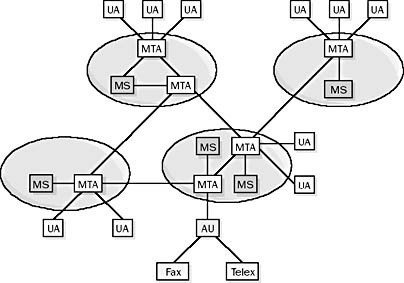X.400 is a set of standards defined in 1984 and 1988 by the International Telecommunication Union (ITU) for computer-based handling of e-mail.
What is X.400?
A set of standards defined in 1984 and 1988 by the International Telecommunication Union (ITU) for computer-based handling of e-mail. The X.400 standard is based on the Open Systems Interconnection (OSI) reference model and other protocols developed by theInternational Organization for Standardization (ISO). X.400 provides global standards that enable users to send e-mail between any X.400-compliant messaging systems. X.400 is widely considered to be the standard framework for global messaging, although the Simple Mail Transfer Protocol (SMTP) for Internet e-mail might have an even better claim to the title. X.400 is widely implemented in Europe by most post, telephone, and telegraph (PTT) authorities. Microsoft Exchange Server supports messaging connectivity with X.400 mail systems through the X.400 Connector, an optional component available with the Enterprise Edition of Exchange Server 5.5.
How X.400 Works
X.400 defines a global Message Handling System (MHS) that consists of a number of messaging components. From an administrative point of view, the building blocks of the MHS are management domains (MDs). (MDs are not the same as DNS domains – the Domain Name System [DNS] is used for SMTP mail, not X.400 messaging services.) A management domain is a collection of messaging systems with at least one Message Transfer Agent (MTA)managed by a specific organization. X.400 management domains come in two varieties:
- Administrative Management Domains (ADMDs): Messaging systems managed by an administrator or a registered private agency. These are the top-level management domains that handle third-party messaging traffic. An example is a telephone carrier service company such as AT&T.
- Private Management Domains (PRMDs): Unique subscriptions to an ADMD, such as telephone numbers of users. PRMDs can send or receive messages from an ADMD, but PRMDs cannot communicate directly with each other.
An X.400 MHS consists of the following five kinds of messaging components:
- Message Transfer Systems (MTS’s): Collections of one or more MTAs that function together to provide message forwarding services for a particular X.400 domain.
- Message Transfer Agents (MTAs): Route and deliver transport messages to and from User Agents (UAs) and with other MTAs. An MTA corresponds to a mail server in a typical LAN–based messaging system. MTAs maintain a database of all UAs registered in their domain and routing tables that indicate how messages should be forwarded to other domains.
- Messages Stores (MS’s): Temporarily store messages that an MTA has received until they can be processed and forwarded for delivery. X.400 thus uses a store-and-forward method of message delivery.
- User Agents (UAs): Provide messaging functionality directly to users. From a practical point of view, a UA can be identified as the e-mail client software that a user is running; from an abstract point of view, a UA is a domain belonging to a user and consisting of additional subcomponents. The goal of an X.400 MHS is to facilitate exchange of messages between different UAs.
- Access Units (AUs): Gateways between an X.400 MHS and another messaging system such as a telex or fax system.

Each UA in an X.400 MTS is identified by a special X.400 address called an Originator/Recipient (O/R) address. The O/R address is the e-mail address of the X.400 user and can be quite complex compared to an SMTP e-mail address. (This is one reason that SMTP is overtaking X.400 in popularity.) An O/R address consists of a series of VALUE=ATTRIBUTE pairs separated by semicolons. Not all fields need to be complete – only those that uniquely identify the recipient are required. Here is an example of an X.400 address:
C=US;A=MCI;P=MICROSOFT;O=SALES;S=SMITH;G=JEFF;
The individual address fields are as follows:
- Country (C) is United States
- ADMD (A) is MCI
- PRMD (P) is Microsoft (company name)
- Organization (O) is Sales Department of Microsoft
- Surname (S) is Smith
- Given name (G) is Jeff
An X.400 message consists of a P1 envelope and its P2/22 message contents. The envelope contains the e-mail address information needed for routing the message to its destination. The X.400 protocol for a message envelope includes support for message tracking and delivery priority features. The X.400 protocol for the message content includes a header and body part for the message.
What typically happens in the message transfer process is that a UA sends a message addressed to another UA in the MHS. The message is forwarded to an MTA in the local MTS, which either delivers the message locally or forwards it to a remote MTA for handling, depending on where the destination UA is located. The message is passed from MTA to MTA until it reaches the MTS of the destination UA, whereupon it is either delivered if the destination UA is connected or stored in an MS until the UA can retrieve it.